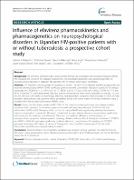| dc.contributor.author | Mukonzo, Jackson K | |
| dc.contributor.author | Okwera, Alphonse | |
| dc.contributor.author | Nakasujja, Neoline | |
| dc.contributor.author | Luzze, Henry | |
| dc.contributor.author | Waako, Paul. | |
| dc.contributor.author | Ogwal-Okeng, Jasper | |
| dc.contributor.author | Gustafsson, Lars L | |
| dc.contributor.author | Aklillu, Eleni | |
| dc.date.accessioned | 2019-10-31T10:08:17Z | |
| dc.date.available | 2019-10-31T10:08:17Z | |
| dc.date.issued | 2013 | |
| dc.identifier.citation | Mukonzo, J. K., Okwera, A., Nakasujja, N., Luzze, H., Sebuwufu, D., Ogwal-Okeng, J., ... & Aklillu, E. (2013). Influence of efavirenz pharmacokinetics and pharmacogenetics on neuropsychological disorders in Ugandan HIV-positive patients with or without tuberculosis: a prospective cohort study. BMC infectious diseases, 13(1), 261. | en_US |
| dc.identifier.uri | https://hdl.handle.net/123456789/82 | |
| dc.description.abstract | Background: HIV infection, anti-tuberculosis and efavirenz therapy are associated with neuropsychological effects.
We evaluated the influence of rifampicin cotreatment, efavirenz pharmacokinetics and pharmacogenetics on
neuropsychiatric disorders in Ugandan HIV patients with or without tuberculosis coinfection.
Methods: 197 treatment naïve Ugandan HIV patients, of whom 138 were TB co-infected, enrolled prospectively and
received efavirenz based HAART. TB-HIV confected patients received concomitant rifampicin based anti-TB therapy.
Genotypes for CYP2B6 (*6, *11), CYP3A5 (*3, *6, *7), ABCB1 (c.3435C>T and c.4036 A/G rs3842), CYP2A6 (*9, *17) and
NR1I3 rs3003596 T/C were determined. Efavirenz plasma concentrations were serially quantified at 3rd day, 1st, 2nd,
4th, 6th, 8th and 12th weeks during therapy. Efavirenz neuropsychiatric symptoms were evaluated in terms of sleep
disorders, hallucinations and cognitive effects at baseline, at two and twelve weeks of efavirenz treatment using a
modified Mini Mental State Examination (MMSE) score.
Results: During the first twelve weeks of ART, 73.6% of the patients experienced at least one efavirenz related
neuropsychiatric symptom. Commonest symptoms experienced were sleep disorders 60.5% (n=124) and
hallucination 30.7% (n=63). Neuropsychiatric symptoms during HAART were significantly predicted by efavirenz
plasma concentrations consistently. Rifampicin cotreatment reduced plasma efavirenz concentrations significantly
only during the first week but not afterwards. There was no significant difference in the incidence of
neuropsychiatric symptoms between patients receiving efavirenz with or without rifampicin cotreatment. CYP2B6*6
and ABCB1 c.4036 A/G genotype significantly predicted efavirenz concentrations. The tendency of CYP2B6*6
genotype association with higher incidence of having vivid dream (p=0.05), insomnia (p=0.19) and tactile
hallucination (p=0.09) was observed mainly at week-2.
Conclusions: Efavirenz related neuropsychiatric symptoms are common among Ugandan HIV patients receiving
ART and is mainly predicted by higher efavirenz plasma concentrations and CYP2B6 genotype but not by rifampicin
based anti-TB co-treatment. | en_US |
| dc.language.iso | en | en_US |
| dc.publisher | BMC Infectious Diseases | en_US |
| dc.subject | Efavirenz | en_US |
| dc.subject | Neuropsychiatric toxicity | en_US |
| dc.subject | Rifampicin | en_US |
| dc.subject | CYP2B6 | en_US |
| dc.subject | HIV | en_US |
| dc.subject | Tuberculosis | en_US |
| dc.subject | CNS | en_US |
| dc.subject | Antiretroviral therapy | en_US |
| dc.subject | Ugandans | en_US |
| dc.subject | Uganda | en_US |
| dc.title | Influence of efavirenz pharmacokinetics and pharmacogenetics on neuropsychological disorders in Ugandan HIV-positive patients with or without tuberculosis: a prospective cohort study | en_US |
| dc.type | Article | en_US |

